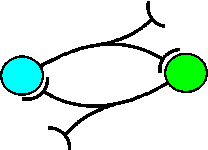
Very little in our world resolves to tidy values that we know with high accuracy.
Either the time cannot be spent to know, or the thing being tracked is changing at a rate
that makes the task of accurate measurement fruitless. If we are to use computers in
areas where humans shine, we need to handle variability and ambiguity. This applies both
to values and to structure, meaning that the messages we propagate have to be able to
modify the structure through which they pass, as well as the values of parameters. The
self-modifiability imposes a very strong constraint on what the structure can be made of,
and almost guarantees that it must be realised, rather than hidden away in a stream of
computer instructions.
If we accept that messages must be able to change structure, then messages cannot be simple values, only resolving to parameters for the recipient. Complex messages require paths down which to propagate, and it appears beneficial if those paths are not directed. Humans don't have undirected structures at the base level in their brains, but if one goes up enough levels, their thought processes become unhindered by the physical limitations of the base level.
If we build systems that are limited to the passing of single values down paths predirected by assignment, we should have predicted all the limitations that they have been shown to have.